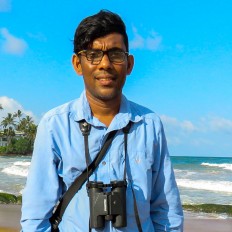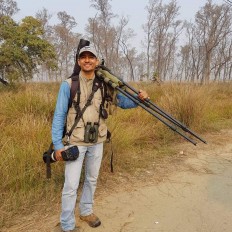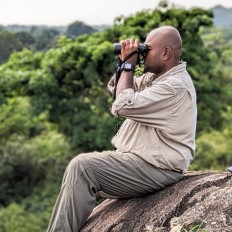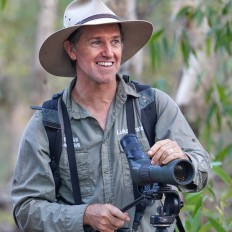European Winter Season is theBesttime of the year forthis National Park. Most of the avifauna is Winter Migrants. And the best time if the day is the Earliext of the morning.
When turned I. Ti the National Parkfrom the Debarwewa - Hambanthota Main road there's a large mostly freshwater Marsh in either side of the road. Great birding area. Especially the first light of the day t3nd to bring out everything. Specia,ties are Black- crowned Night-heron, Eurasian Collard Dove, Watercock and Clamorous Reed-warblers. You might find Sand Martin/Bank Swallow perched on the electric wires by the left side along the road.
Afterthatmarsh you'll pass the Bundala National Park management' office and the I formation centre. You obtain ticket from their and continue on the same road you were on before. In less than ti met therea kilometre on the right is a dirt track to entertain national parks, large area. They'll che k your ticket and you can drive in. No walking in the park. You must be Driving or being driven.
There are safarinjeeps available. Most of the regular cars cannot be driven in the National Park. Most roads go through marshy areas. Arrange a Safari jeep in advance. I'd be happy to assist you on anything regarding. (My WhatsApp +94769657576)
Several type of habitats exists within the park. Give priority to the marshes and the saltern. Shrub forest also has species like Bay-backed Shrike (1 bird) Lesser Whitethroat, Yellow-crowned Woodpecker, Brahminy Sterling,Sri Lanka Wood shrike
It pays to have a local guide with you when visiting this Natiknal park. Even though it's a Bird abundant park looking for Specialties and Rarities require some locally sourced help.
,
European Winter Season is theBesttime of the year forthis National Park. Most of the avifauna is Winter Migrants. And the best time if the day is the Earliext of the morning.
When turned I. Ti the National Parkfrom the Debarwewa - Hambanthota Main road there's a large mostly freshwater Marsh in either side of the road. Great birding area. Especially the first light of the day t3nd to bring out everything. Specia,ties are Black- crowned Night-heron, Eurasian Collard Dove, Watercock and Clamorous Reed-warblers. You might find Sand Martin/Bank Swallow perched on the electric wires by the left side along the road.
Afterthatmarsh you'll pass the Bundala National Park management' office and the I formation centre. You obtain ticket from their and continue on the same road you were on before. In less than ti met therea kilometre on the right is a dirt track to entertain national parks, large area. They'll che k your ticket and you can drive in. No walking in the park. You must be Driving or being driven.
There are safarinjeeps available. Most of the regular cars cannot be driven in the National Park. Most roads go through marshy areas. Arrange a Safari jeep in advance. I'd be happy to assist you on anything regarding. (My WhatsApp +94769657576)
Several type of habitats exists within the park. Give priority to the marshes and the saltern. Shrub forest also has species like Bay-backed Shrike (1 bird) Lesser Whitethroat, Yellow-crowned Woodpecker, Brahminy Sterling,Sri Lanka Wood shrike
It pays to have a local guide with you when visiting this Natiknal park. Even though it's a Bird abundant park looking for Specialties and Rarities require some locally sourced help.
,
European Winter Season is theBesttime of the year forthis National Park. Most of the avifauna is Winter Migrants. And the best time if the day is the Earliext of the morning.
When turned I. Ti the National Parkfrom the Debarwewa - Hambanthota Main road there's a large mostly freshwater Marsh in either side of the road. Great birding area. Especially the first light of the day t3nd to bring out everything. Specia,ties are Black- crowned Night-heron, Eurasian Collard Dove, Watercock and Clamorous Reed-warblers. You might find Sand Martin/Bank Swallow perched on the electric wires by the left side along the road.
Afterthatmarsh you'll pass the Bundala National Park management' office and the I formation centre. You obtain ticket from their and continue on the same road you were on before. In less than ti met therea kilometre on the right is a dirt track to entertain national parks, large area. They'll che k your ticket and you can drive in. No walking in the park. You must be Driving or being driven.
There are safarinjeeps available. Most of the regular cars cannot be driven in the National Park. Most roads go through marshy areas. Arrange a Safari jeep in advance. I'd be happy to assist you on anything regarding. (My WhatsApp +94769657576)
Several type of habitats exists within the park. Give priority to the marshes and the saltern. Shrub forest also has species like Bay-backed Shrike (1 bird) Lesser Whitethroat, Yellow-crowned Woodpecker, Brahminy Sterling,Sri Lanka Wood shrike
,






